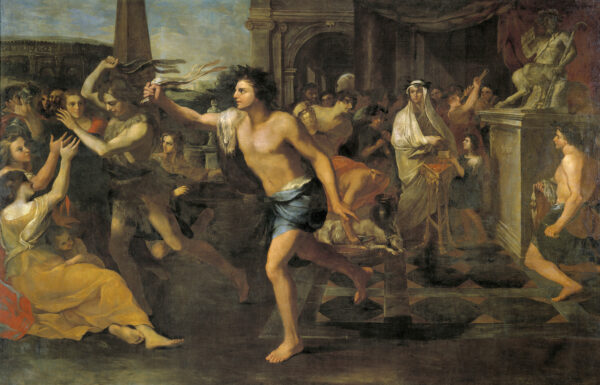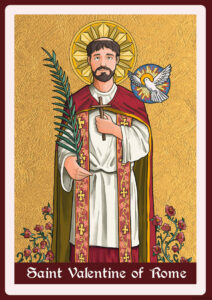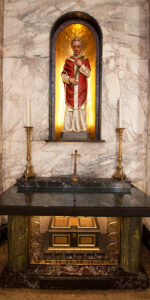
Ahh February 14th – the most rosemantic day of the year, but what’s the story behind it all?
The true history of Saint Valentine is unclear but according to a few sources, long ago in 270 A.D. from February 13th-15th, a feast known as Lupercalia, which was an ancient pagan festival to purify the city, saw drunk naked men sacrifice a goat and a dog, then they would whip women with the hides of the animals that they had just slain. Young women would apparently line up for the men to hit them as they believed this would make them fertile (who said romance was dead?) Then the men would randomly choose a woman’s name from a jar like a matchmaking lottery system to be coupled up with for the duration of the festival. In many cases these couples would fall in love and plan to be married. But the Roman empire still ruled Europe then and outlawed the growing Christian religion and all things associated with it, including marriage. The emperor, Claudius II Gothicus disapproved of any traditions that pushed men and women to marry as he wanted to recruit lots of men to be soldiers in his army, and in his eyes their first duty was to fight. Despite this, a number of priests performed marriage rites against the wishes of the emperor.

St Valentine was one of these men.
He was an Italian doctor who later became a priest. Other narratives identify him as the bishop of Terni, in Italy, but it is possible that these are different versions of the same original account and refer to only one person. Historians pick up on his life after he began working as a priest when he became famous for marrying couples who were in love, but who couldn’t legally get married in Rome. He was also trying to convert people to Christianity and was a healer. But when Claudius found out what Valentine was doing he sent him to jail. Valentine used this time in jail to continue to reach out to people with the love that he said Jesus Christ gave to him for others.
According to one legend, he befriended his jailor who had asked Valentine to help his blind daughter, Julia, with her lessons. Valentine would read material for her to learn when she would come to visit him in jail. Emperor Claudius came to like Valentine also and offered to pardon him and set him free if he would renounce his Christian faith and agree to worship the Roman Gods. Valentine’s refusal cost him his life as Claudius was so enraged at his response, that he sentenced him to death.
But before he was killed, Valentine wrote a last note to encourage Julia to stay close to Jesus and to thank her for being his friend. He signed the note, “From your Valentine” (regarded as the first ever Valentine card).

Whitefriar Street Church
Poor Valentine was beaten, stoned and beheaded on February 14th. People who remembered his loving service to many young couples started celebrating his life, and he came to be regarded as a saint through whom God had worked to help people to recognise and experience true love. It is said that the farewell note that he sent to Julia had a yellow crocus inside which healed her eyesight.
The legacy of St Valentine has survived long after his death and there was such an uproar over his execution among the Christian community in Rome that the authorities had to bury his body quickly to avoid a riot. But three of his followers found him and took him to Terni where he was perfectly embalmed in the Basilica di San Valentino.
By 496, in honour of his martyrdom, Pope Gelasius designated February 14th as the Feast of St Valentine.
He is also the Patron saint of lovers, epileptics and beekeepers!
Throughout the centuries though there have been many basilicas, monasteries and churches built over the site of his grave and in the early 1800’s when work was being carried out Valentine’s remains were found along with a small vial of his blood and other artefacts.
In 1835 an Irish Carmelite by the name of Father John Spratt was visiting Rome and the most faithful of the city came out to hear him preach when he was invited to speak at the Church of the Gesu. He received many tokens of gratitude and respect from the church, including saintly relics. One such token came from Pope Gregory XVI (1831-1846) and were the remains of Saint Valentine.

On November 10th, 1836, the remains arrived in Dublin and were brought to Whitefriar Street Church in Aungier Street in Dublin 2 and were put into storage. During a major renovation in the church in the 50’s and 60’s they were returned to prominence with an altar and shrine to house them.
Today, the shrine is visited throughout the year by singletons and couples who come to pray to St Valentine and ask him to watch over them in their quest for true love and marriage and happy ever afters. There is also a book in the church in which people have written their countless wishes and prayer requests for love.
St Valentine is represented in pictures with birds and roses and his legacy lives on in today’s world when we sign Valentine’s cards with adoration, funny poems and seal it with a kiss. We send tokens of deep affection with flowers, chocolates and teddy bears. We celebrate all types of connections because of a man who truly believed in the power of love.
For more Valentine stories see pg. 8, and all your smoochy Valentine films on pg. 16.



